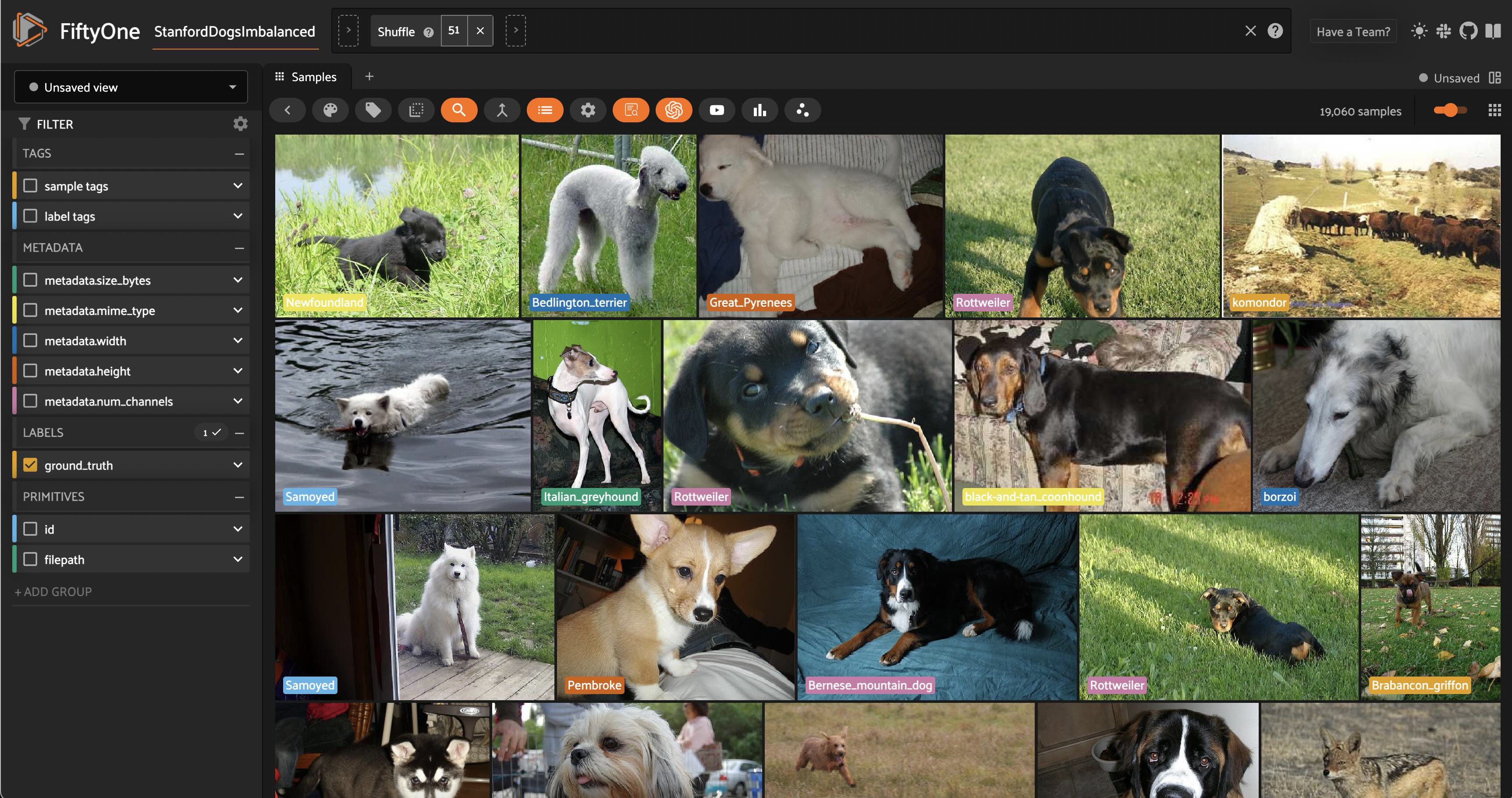Datasets:
Tasks:
Image Classification
Modalities:
Image
Languages:
English
Size:
10K<n<100K
Libraries:
FiftyOne
metadata
annotations_creators: []
language: en
size_categories:
- 10K<n<100K
task_categories:
- image-classification
task_ids: []
pretty_name: StanfordDogsImbalanced
tags:
- fiftyone
- image
- image-classification
dataset_summary: >

This is a [FiftyOne](https://github.com/voxel51/fiftyone) dataset with 19060
samples.
## Installation
If you haven't already, install FiftyOne:
```bash
pip install -U fiftyone
```
## Usage
```python
import fiftyone as fo
import fiftyone.utils.huggingface as fouh
# Load the dataset
# Note: other available arguments include 'max_samples', etc
dataset = fouh.load_from_hub("Voxel51/Stanford-Dogs-Imbalanced")
# Launch the App
session = fo.launch_app(dataset)
```
Dataset Card for StanfordDogsImbalanced
This is a FiftyOne dataset with 19060 samples.
Installation
If you haven't already, install FiftyOne:
pip install -U fiftyone
Usage
import fiftyone as fo
import fiftyone.utils.huggingface as fouh
# Load the dataset
# Note: other available arguments include 'max_samples', etc
dataset = fouh.load_from_hub("Voxel51/Stanford-Dogs-Imbalanced")
# Launch the App
session = fo.launch_app(dataset)
Dataset Details
Dataset Description
An imbalanced version of the Stanford Dogs dataset designed for testing class imbalance mitigation techniques, including but not limited to synthetic data generation.
This version of the dataset was constructed by randomly splitting the original dataset into train, val, and test sets with a 60/20/20 split. For 15 randomly chosen classes, we then removed all but 10 of the training examples.
# Split the dataset into train, val, and test sets
import fiftyone.utils.random as four
train, val, test = four.random_split(dataset, split_fracs=(0.6, 0.2, 0.2))
splits_dict = { "train": train, "val": val, "test": test }
# Get the classes to limit
import random
classes = list(dataset.distinct("ground_truth.label"))
classes_to_limit = random.sample(classes, 15)
# Limit the number of samples for the selected classes
for class_name in classes_to_limit:
class_samples = dataset.match(F("ground_truth.label") == class_name)
samples_to_keep = class_samples.take(10)
samples_to_remove = class_samples.exclude(samples_to_keep)
dataset.delete_samples(samples_to_remove)
- Curated by: [More Information Needed]
- Funded by [optional]: [More Information Needed]
- Shared by [optional]: [More Information Needed]
- Language(s) (NLP): en
- License: [More Information Needed]
Dataset Sources
- Paper: [More Information Needed]
- Homepage: [More Information Needed]
Uses
- Fine-grained visual classification
- Class imbalance mitigation strategies
Dataset Structure
The following classes only have 10 samples in the train split:
- Australian_terrier
- Saluki
- Cardigan
- standard_schnauzer
- Eskimo_dog
- American_Staffordshire_terrier
- Lakeland_terrier
- Lhasa
- cocker_spaniel
- Greater_Swiss_Mountain_dog
- basenji
- toy_terrier
- Chihuahua
- Walker_hound
- Shih-Tzu
- Newfoundland
Citation
BibTeX:
@inproceedings{KhoslaYaoJayadevaprakashFeiFei_FGVC2011,
author = "Aditya Khosla and Nityananda Jayadevaprakash and Bangpeng Yao and Li Fei-Fei",
title = "Novel Dataset for Fine-Grained Image Categorization",
booktitle = "First Workshop on Fine-Grained Visual Categorization, IEEE Conference on Computer Vision and Pattern Recognition",
2011,
month = "June",
address = "Colorado Springs, CO",
}
